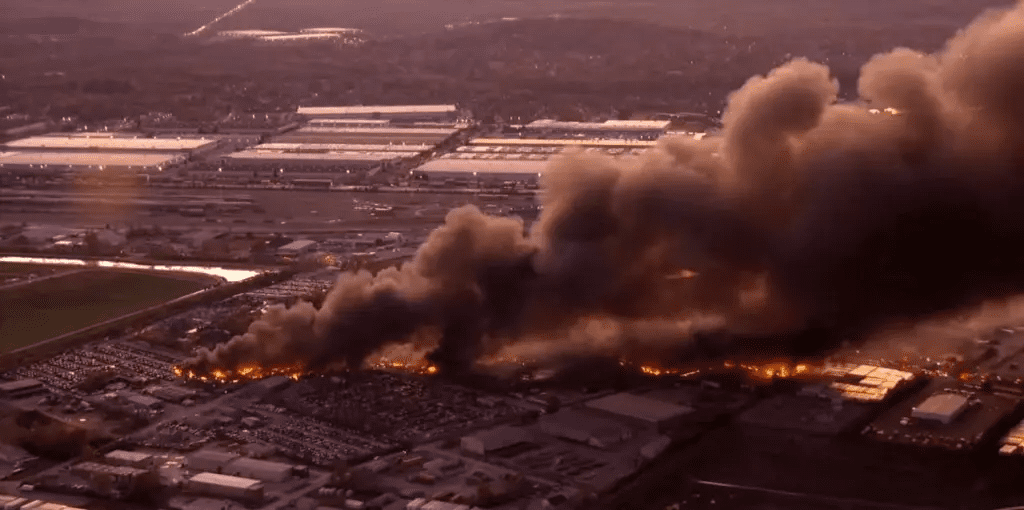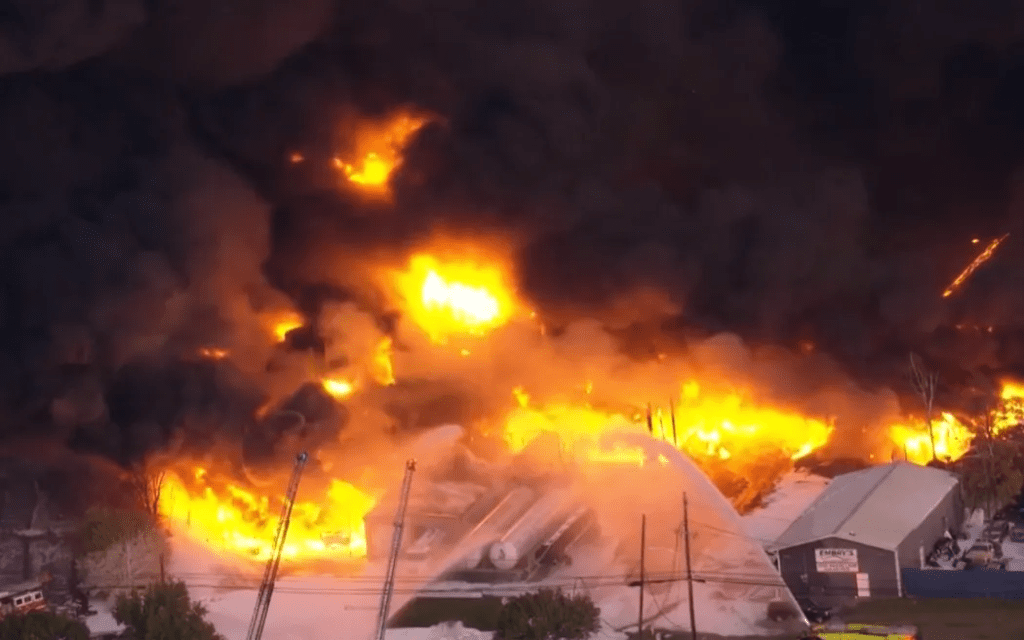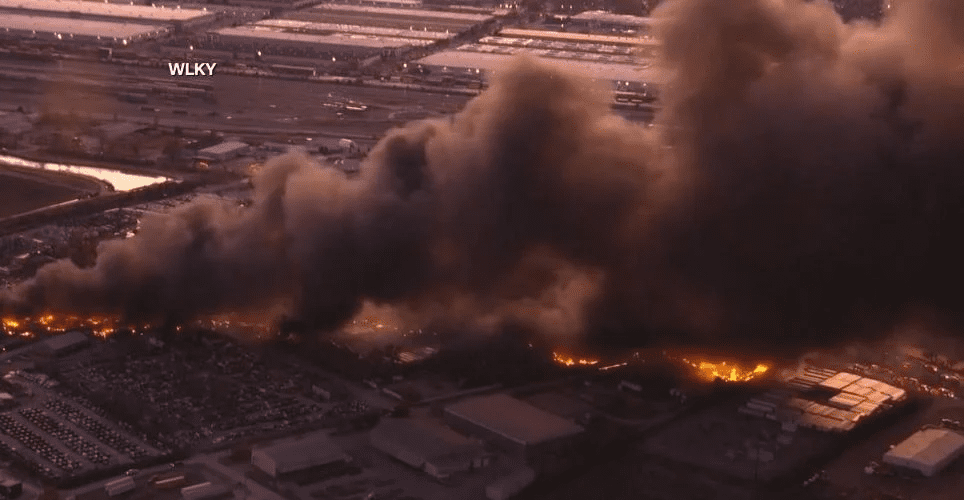Dramatic Crash of UPS Flight 2976 Near Louisville’s Airport Triggers Fiery Explosion and City-Wide Shelter-In-Place Order
In the early evening of Tuesday, November 4, 2025, skies over Louisville, Kentucky, darkened with an ominous plume of black smoke that stretched for miles. The city’s largest cargo carrier, UPS Airlines, confirmed that one of its aircraft, operating as UPS Flight 2976, crashed shortly after takeoff from Louisville Muhammad Ali International Airport (SDF), igniting a massive blaze and forcing authorities to issue a shelter-in-place order across a broad swath of the city. The airport hub, long a vital node in UPS’s global logistics network, suddenly became the site of a dramatic and frightening accident.

At approximately 5:15 p.m. local time, the McDonnell Douglas MD-11 freighter began its departure from SDF, bound for Honolulu, Hawaii. Federal Aviation Administration (FAA) records confirm the aircraft lifted and then abruptly crashed in the vicinity of the airport grounds, as the airport’s daily operations were forced to a halt. The shelter-in-place directive initially covered a five-mile radius, later extending northward to the Ohio River, while local law-enforcement described the scene as “active with fire and debris.” Investigators from the FAA and the National Transportation Safety Board (NTSB) have opened a formal inquiry.

Images and video shared by residents shortly after the crash captured the horrifying moment: the aircraft engulfed in flames, fuel igniting nearby structures, and a thick black cloud rising above the airport’s 5.2 million-square-foot sorting facility known as “Worldport.” That facility is the center of UPS’s U.S. air-cargo operations—processing more than 400,000 packages an hour and dispatching some 300 flights daily. In the aftermath of the crash, officials warned of serious risk to surrounding neighborhoods and asked residents to shelter immediately.
UPS issued a brief statement confirming the incident and that it was “notified of an aircraft incident involving one of its planes.” The company did not immediately provide details on fatalities or the condition of the crew. Louisville Metro Police Department (LMPD) posted on X (formerly Twitter) that multiple agencies responded to reports of a crash near Grade Lane and Fern Valley Road, close to the airport perimeter. “This is an active scene with fire and debris,” the LMPD wrote, urging the public to stay clear of the area. Reports indicated that the aircraft would have been heavily fueled for its nonstop flight to Hawaii, heightening the severity of the fire and explosion.

The city’s governor, Andy Beshear, issued a statement acknowledging the seriousness of the situation: “Kentucky, we are aware of a reported plane crash near Louisville International Airport. First responders are on site and we will share more information as available. Please pray for the pilots, crew and everyone affected.” Local news outlets described the hour-by-hour escalation of danger as the fire spread to nearby buildings and threatened to disrupt operations at the heart of UPS’s global freight network.
For residents in the surrounding neighborhoods, the event was surreal. One witness seven minutes from the airport described hearing explosions and seeing flames tearing across the horizon. The typical hum of cargo-aircraft operations was replaced by chaos and smoke. Roads were blocked, flights were suspended, and the shelter-in-place order turned a routine Tuesday evening into one of crisis and uncertainty. For a city so embedded in the logistics of global commerce, the crash served as a stark reminder of the stakes that accompany high-volume, heavy-fuel aviation operations.
From a broader perspective, the incident raises questions about aviation safety, cargo-fleet risk and infrastructure vulnerability. McDonnell Douglas MD-11 freighters, once a workhorse of air-cargo fleets, operate in demanding conditions with heavy loads and tight schedules. While the MD-11 has been used for decades, modern safety standards continue to evolve as fleets age and logistic pressures grow. The heavy fuel load for the long-haul route to Honolulu would have added complexity to any takeoff scenario. Investigators will look closely at takeoff procedures, maintenance records, pilot communications, weather conditions and potential mechanical issues.

While the crash is still under early investigation, its immediate ripple effects are already being felt across the aviation and logistics sectors. The closure of the airfield at SDF forced diversion of flights, disruption to UPS’s hub operations and a sharp halt to one of the busiest cargo processing sites in the nation. Supply-chain planners are watching closely, as the hub plays a pivotal role in overnight shipping, global freight schedules and contract logistics. The cost of such a disruption is difficult to estimate yet potentially significant for timed-sensitive freight networks.
At the community level, the shelter-in-place order and the proximity of the fire to residential and industrial zones underscore the intersection of high-risk aviation operations and urban geographies. With an explosion of this scale, the potential for collateral damage—both to persons and property—was high. Fire-fighting units, hazardous-material teams and local agencies remain engaged in stabilization efforts, and the investigation may continue for many months before a full cause is determined and lessons are drawn.

In the immediate term, the priority remains accounting for the crew, assessing damage, reopening the airport and restoring safe operations at the hub. For UPS, managing the reputational, operational and humanitarian response will matter not just for this incident, but for its global brand as a reliable carrier of goods across continents. For Louisville and Kentucky, the incident becomes part of the city’s history: the night when the heart of the overnight delivery network lurched into crisis.
The crash at Louisville also highlights the hidden risks of globalized logistics: the enormous cargo planes, heavy fuel loads, tight schedules and urban interfaces that most consumers never see. Packages arrive in homes at dawn, but that convenience depends on massive machines lifting off under precarious margins. The accident reveals how swiftly normal operations can turn into disaster scenarios—and how vital coordinated emergency response, infrastructure resilience and safety oversight remain.

As watchers await further updates, what is clear is that the moment carries weight far beyond one plane. It is about supply-chain security, about the communities that live near major logistics hubs, about the legacy of aging fleets and global freight growth. And it is about the human cost when a system built for speed and scale meets a moment of failure. Until the investigators conclude their work, the questions will stack: What caused the crash? How robust was the safety oversight? What damage did fuel-carrier operations do to the surrounding community? What will the implications be for UPS, the airport and the industry at large?
In the hours ahead, Louisville will remember the sight of night sky transformed by smoke and flame. The logistics world will track the unfolding impact on cargo networks. And the aviation community will examine the incident for lessons and warnings. While the names of those involved remain undisclosed, and the full toll not yet known, one thing is certain: the crash of UPS Flight 2976 has left an indelible mark on the city, on the industry and on the many unseen pathways that deliver the world’s goods.



